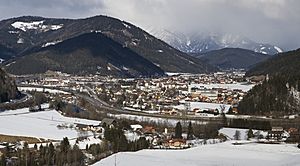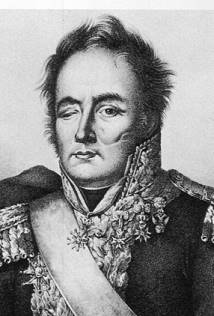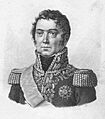Battle of Sankt Michael facts for kids
The Battle of Sankt Michael happened on May 25, 1809. It was a big fight between the French army, led by Paul Grenier, and the Austrian army, led by Franz Jellacic. The battle took place in Sankt Michael in Obersteiermark, Austria. This battle was part of the Napoleonic Wars, specifically the War of the Fifth Coalition. Sankt Michael is about 140 kilometers (87 miles) southwest of Vienna.
Quick facts for kids Battle of Sankt Michael |
|||||||
|---|---|---|---|---|---|---|---|
| Part of the Napoleonic Wars | |||||||
|
|||||||
| Belligerents | |||||||
| Commanders and leaders | |||||||
| Strength | |||||||
| 12,000 to 15,000 | 8,000 to 9,000 | ||||||
| Casualties and losses | |||||||
| 670 | 6,573 | ||||||
General Jellacic's Austrian troops were originally part of a larger army. But they were sent south before a big battle called Battle of Eckmühl. Later, they were told to join another Austrian army led by Archduke John of Austria in Graz.
As Jellacic's troops marched southeast towards Graz, they crossed paths with the French Army of Italy. This French army was led by Eugène de Beauharnais and was chasing Archduke John. When Eugène found out Jellacic was nearby, he sent General Grenier with two divisions to stop the Austrians.
Grenier's first division attacked Jellacic's forces. The Austrians fought back well at first. But they couldn't escape. When the second French division arrived, the French had many more soldiers. Jellacic's army also didn't have enough cavalry (soldiers on horseback) or artillery (cannons). Grenier's next attack broke the Austrian lines. Thousands of Austrian soldiers were captured. When Jellacic finally reached Archduke John, he had only a small part of his original army left.
How the Battle Started
In 1809, France and Austria went to war. Emperor Napoleon quickly defeated the Austrian general Johann von Hiller in battles like Abensberg and Landshut. These battles happened on April 20 and 21. The next day, Napoleon beat Archduke Charles at the Battle of Eckmühl. This forced Archduke Charles to retreat north of the Danube River.
General Hiller's army retreated east. French Marshal André Masséna chased them. At the start of the war, General Jellacic's division was part of Hiller's army. Jellacic was sent to occupy Munich in the south. He later had to retreat to Salzburg.
Jellacic believed cavalry wasn't useful in the mountains. So, he sent most of his cavalry away. On May 4 and 5, Jellacic fought a successful battle at Lueg Pass. His small force of Hungarian and Grenz infantry soldiers stopped a larger group of Bavarian troops.
Meanwhile, in Italy, Archduke John defeated the French general Eugène at the Battle of Sacile on April 16. Eugène gathered more soldiers and became stronger. When Archduke John heard that Archduke Charles was retreating, he also pulled his army back.
On May 8, Eugène and John fought at the Piave River. The Austrians continued to retreat. John split his army. He sent some troops south and took his main army northeast. Eugène followed John with 25,000 soldiers. Eugène entered Villach on May 20.
On May 15, Jellacic was in Salzburg with 10,200 soldiers and 16 cannons. His force included many poorly trained soldiers and only 60 cavalry. Archduke John ordered Jellacic to join him in Graz. Jellacic left Salzburg on May 19. By this time, he was in a dangerous position. Eugène was only 130 km from Graz, while Jellacic was 200 km away.
The Battle Unfolds
On the evening of May 23, Jellacic's troops marched into Mautern in Steiermark. This town was 16 km northwest of Sankt Michael. At the same time, Eugène's main army reached Judenburg, 33 km southwest of Sankt Michael. Eugène soon learned Jellacic was nearby. He ordered General Grenier to quickly march his two divisions, led by Generals Jean Mathieu Seras and Pierre François Joseph Durutte, northeast to stop the Austrians. At some point, Jellacic sent away most of his local militia (Landwehr) and most of his cannons, keeping only four.
Jellacic's first soldiers arrived at Sankt Michael on the morning of May 25. By 9:00 am, most of his division was just north of the town. But Grenier's first French soldiers soon appeared from the southwest. Jellacic sent his 60 horsemen and a light brigade to hold off the French on a ridge west of the town.
At 10:00 am, General Seras attacked the Austrian line. But his troops were pushed back. Seras kept attacking. Soon, the Austrian commander brought in another brigade of about 5,000 soldiers. Jellacic placed his left side near the Mur River and his right side in the northern hills.
Durutte's division arrived in the afternoon. This gave Grenier a big advantage, with about 15,000 soldiers against Jellacic's 8,000. Some sources say it was 12,000 French against 9,000 Austrians.
Grenier planned a two-division attack. He put one brigade in the first line and another in the second. He sent a third brigade through the hills to attack Jellacic's right side and cut off the road back to Mautern. Grenier also sent two battalions along the south bank of the Mur River to attack the Austrian left side.
Jellacic had only a few battalions to defend against these attacks. He had to move soldiers from his center to protect his right side and the Mur River flank. At 4:00 pm, Grenier's main attack broke through the weakened Austrian center. The French also cut off the road to the north. The Austrian army fled in a panic northeast along the Mur valley. The French chased them closely through Leoben and Bruck an der Mur. At Bruck, Jellacic's remaining soldiers turned south towards Graz. Only about 2,000 of Jellacic's troops reached Graz the next day.
Outcome of the Battle
Grenier's attack completely destroyed Jellacic's division. Instead of bringing many new soldiers to Archduke John, Jellacic arrived with less than a third of his original force. The Austrians lost 423 soldiers killed, 1,137 wounded, and 4,963 captured. Another 50 soldiers were missing. The French lost 200 killed, 400 wounded, and 70 captured.
Historians say Jellacic made mistakes by staying in Salzburg too long and by sending away most of his cavalry and cannons. One historian called him "a remarkably unlucky and inept general." Archduke John retreated further, and Eugène continued to chase him. The main French and Austrian armies fought another big battle called the Battle of Raab on June 14.
Images for kids






